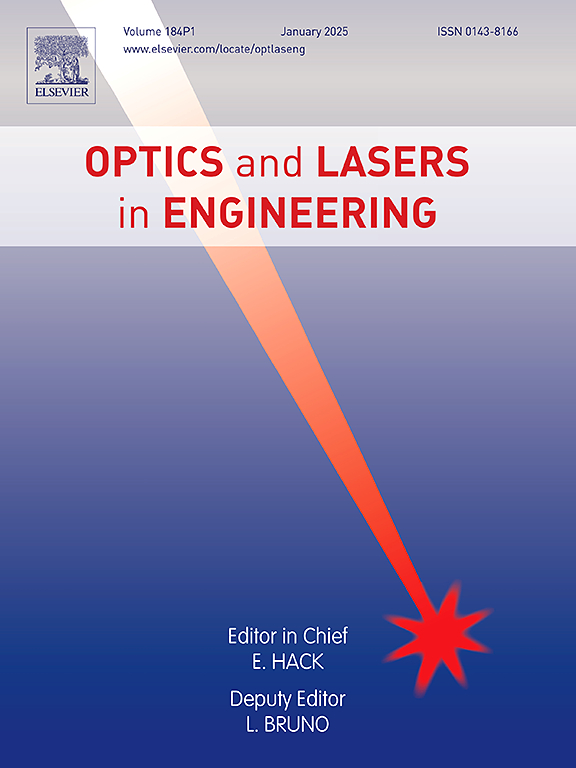Circular marker-aided multi-view laser point cloud registration based on adaptive-weighted bundle adjustment
IF 3.5
2区 工程技术
Q2 OPTICS
引用次数: 0
Abstract
To address the issue of cumulative error leading to poor registration results in multi-view laser point cloud registration aided by circular markers, caused by the reconstruction error of the three-dimensional (3D) coordinates of marker centres and local view transformation matrix estimation error, an Adaptive-Weighted Bundle Adjustment (AWBA) method is proposed. Firstly, coarse registration is achieved based on Euclidean distance matching and angle constraints. Then, an adaptive weighting strategy is introduced to incorporate the accuracy information into the computation of the transformation matrix to improve its estimation accuracy and inhibit the single-view registration error by considering the accuracy difference of the circle centre 3D coordinates. Next, global marker coordinates are optimised by first removing outliers from the sets of homologous points using statistical methods followed by iteratively solving the global marker coordinates using remaining weighted homologous points to improve the accuracy of the global marker. AWBA adopts a synchronous optimisation strategy to calculate the current view transformation matrix based on the latest optimised global markers when the data of a new view is acquired, and it continuously optimises the coordinates of the global marker throughout the reconstruction process to suppress the backward cumulative error. Experimental results demonstrate that AWBA enjoys state-of-the-art performance compared with other methods, with Absolute Error (AE) <0.094 mm for the standard ball radius, model Mean Absolute Distance (MAD) <0.093 mm, and Successful Registration Rate (SRR) greater than 93.010. AWBA can enhance the registration effect of multi-view laser point clouds with a wide range of applications in industrial inspection, robotic navigation and cultural heritage preservation.
基于自适应加权束调整的环形标记辅助多视角激光点云注册
在使用圆形标记辅助进行多视角激光点云注册时,由于标记中心三维(3D)坐标的重建误差和局部视图变换矩阵的估计误差,会产生累积误差,导致注册效果不佳,为了解决这一问题,我们提出了一种自适应加权捆绑调整(AWBA)方法。首先,根据欧氏距离匹配和角度约束实现粗配准。然后,引入自适应加权策略,将精度信息纳入变换矩阵的计算,以提高其估计精度,并通过考虑圆心三维坐标的精度差异来抑制单视图配准误差。接下来,首先利用统计方法剔除同源点集中的异常值,然后利用剩余的加权同源点迭代求解全局标记坐标,从而优化全局标记坐标,提高全局标记的精度。AWBA 采用同步优化策略,在获取新视图数据时,根据最新优化的全局标记计算当前视图变换矩阵,并在整个重建过程中持续优化全局标记坐标,以抑制后向累积误差。实验结果表明,与其他方法相比,AWBA 具有最先进的性能,标准球半径的绝对误差(AE)为 0.094 毫米,模型平均绝对距离(MAD)为 0.093 毫米,成功注册率(SRR)大于 93.010。AWBA 可以增强多视角激光点云的配准效果,在工业检测、机器人导航和文化遗产保护等领域有着广泛的应用。
本文章由计算机程序翻译,如有差异,请以英文原文为准。
求助全文
约1分钟内获得全文
求助全文
来源期刊

Optics and Lasers in Engineering
工程技术-光学
CiteScore
8.90
自引率
8.70%
发文量
384
审稿时长
42 days
期刊介绍:
Optics and Lasers in Engineering aims at providing an international forum for the interchange of information on the development of optical techniques and laser technology in engineering. Emphasis is placed on contributions targeted at the practical use of methods and devices, the development and enhancement of solutions and new theoretical concepts for experimental methods.
Optics and Lasers in Engineering reflects the main areas in which optical methods are being used and developed for an engineering environment. Manuscripts should offer clear evidence of novelty and significance. Papers focusing on parameter optimization or computational issues are not suitable. Similarly, papers focussed on an application rather than the optical method fall outside the journal''s scope. The scope of the journal is defined to include the following:
-Optical Metrology-
Optical Methods for 3D visualization and virtual engineering-
Optical Techniques for Microsystems-
Imaging, Microscopy and Adaptive Optics-
Computational Imaging-
Laser methods in manufacturing-
Integrated optical and photonic sensors-
Optics and Photonics in Life Science-
Hyperspectral and spectroscopic methods-
Infrared and Terahertz techniques
 求助内容:
求助内容: 应助结果提醒方式:
应助结果提醒方式:


